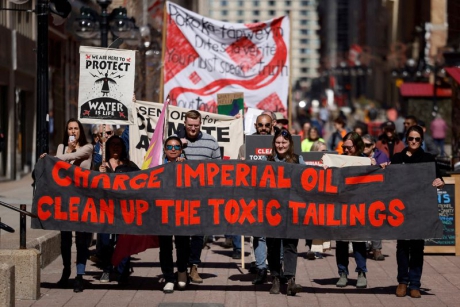Reports
You are here
Charge Imperial Oil for cover-up of toxic tar sands tailings leak

May 11, 2023
Kept in the dark about toxic tar sands “tailings” leaking from the Imperial Oil Kearl facility for 9 months, northern Alberta First Nations lambasted the Alberta energy regulator at a hearing of the Committee on Environment and Sustainable Development on April 17th, “All trust with the Alberta government has been broken … they cannot be trusted to oversee this mess” said Chief Allan Adam of Athabasca Chipewyan First Nation.
Kearl’s “tailings” containment structures failed in May, 2022 but the Alberta Energy Regulator (AER) only went public this February and the company never informed the nearby First Nations of the leak. The Committee heard how AER reflects “the interests of the regulated parties rather than the public interest.”
This “crisis shows these failures on multiple fronts and we fear that Kearl is just the tip of the iceberg. We are bracing for even more catastrophic events unless there are real reforms,” said Mikisew Cree First Nation Chief Billie-Joe Tuccaro.
Daniel Stuckless, director of the Fort McKay Métis Nation was more direct: “scrap it and build it back.”
Tar sands extraction is wholly a Canadian settler colonial project, first developed to use the bitumen as a road paving material in the mid-20th century and only later as a source of fossil fuel energy. They were developed on Treaty 8 lands without regard to the local Indigenous populations, who assert their treaty rights to use their traditional lands.
However, tar sands oil projects were undertaken with no regard to these rights. Production expanded five-fold from under 100,000 barrels per day in the early 1970s to the mid-1990s: then it exploded, surpassing a million barrels per day by 2005, inexorably rising to its current level of over 3 million barrels per day.
The expansion of tar sands oil production has had a devastating environmental impact on the First Nations in the area and farther north to the Arctic Circle along the route of the Athabasca River. The incidences of rare cancers and other illnesses is higher here than in communities in the southern parts of the province. The removal of boreal forest to access the bitumen has destroyed ecosystems that Indigenous people in the area have stewarded and relied on since time immemorial.
As the scale of production has risen, so too has the scale of the toxic tailings which are visible from space. In 2020 these toxic “ponds” encompassed an area of about 120 square kilometers. The industry admits that containment structures cannot prevent seepage to the local environment, and their regular failure demonstrates the lack of a permanent solution to the problems of waste from this industry. Instead the industry and regulators ask First Nations and the public to trust them to contain the risks.
It is reminiscent of the nuclear industry saying don’t worry about radioactive waste because the technological fix will eventually be found. Meanwhile, the dangerous waste piles up and threatens communities in its shadow.
Impact benefit agreements that First Nations have signed, in an attempt to limit the risks of tar sands development, and for jobs and the funding of local services for their people have made band council leaders reticent to speak out. This is beginning to change with recent failures of industry and the regulator to even inform, much less contain the toxic mess.
ACFN Chief Adam also pointed the finger at the federal government for “the lack of enforcement, lack of funding, lack of political will” and called for federal government intervention.
But the AER and the provincial and federal governments bend over backwards for the tar sands industry, despite the crocodile tears of Imperial Oil CEO, Brad Corson.
The truth is there is no safe way to continue expanding tar sands production, both because it destroys the local ecosystems that Indigenous peoples have stewarded for millennia and because it will release planet killing quantities of carbon if allowed to continue.
Tar sands workers are trapped in jobs that perpetuate this destruction, in conditions dangerous to their health, and susceptible to replacement by automation. Many jobs in this industry are relatively high paying, but they are not immune from the impact of inflation and union busting: recently, 400 kitchen, housekeeping and janitorial workers represented by UFCW Local 401 at Wapasu Creek Lodge, a work camp for Kearl tar sands workers, were issued pink slips after voting down a $7 per hour decrease in pay from the camp operator Civeo last November. Many of these workers are members of the local First Nations.
Building solidarity between Indigenous fights for sovereignty over their treaty lands, which includes their traditional rights to hunt, fish and trap, and the fights of workers for better wages and working conditions is crucial to winning a vision for a just transition to a world where working and living can be brought into alignment with the environment that humans and all living beings rely on to survive.
Section:










